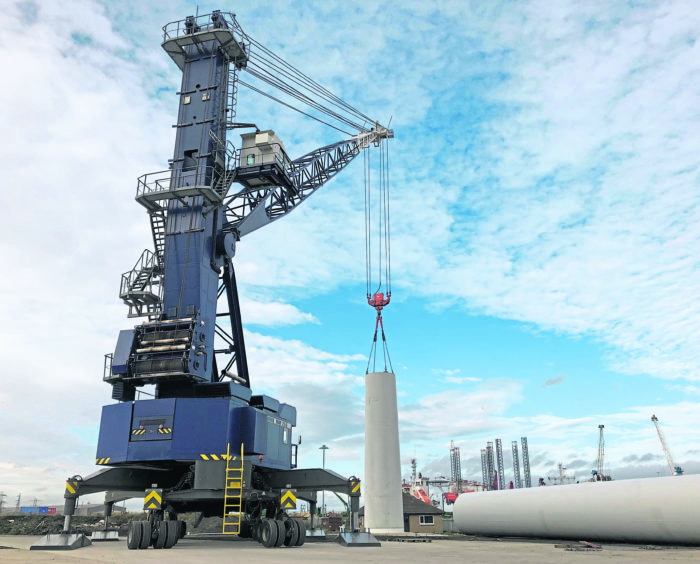
The success of the southern North Sea’s offshore wind sector not only makes it an interesting hotbed of renewable energy activity in the UK, it also points toward the future developments of the sector and how it is helping some forgotten coastal communities engineer a brighter future for themselves.
Tony Quinn, test and validation director for the Offshore Renewable Energy (ORE) Catapult at the Port of Blyth in Northumberland, believes the region has a new story to tell, one that harks back to its subsea engineering past and could see it become an onshore base for the world’s next mammoth wind farm.
ORE Catapult, which also has an office in Glasgow, currently employs around 100 workers at the Port of Blyth – but Mr Quinn claims the area has the potential for thousands more.
The Catapult signed a landmark deal with multinational firm General Electric (GE) Renewable Energy in 2018 to test much of GE Renewable Energy’s Haliade-X 12 megawatt offshore wind turbine and blades.
GE’s more than 350ft blade, made by LM Wind Power, is currently in Blyth to assess its ability to withstand peak wind conditions and simulating its readiness for years of operation at sea.
The nacelle – which holds and spins the blades – is the size of six double-decker buses.
Quinn describes the contract as the port’s “biggest success to date”.
He said: “We’ve got these big turbine test assets in Blyth, probably the largest of their type in the world.
“Attracting GE to carry out onshore testing here is an outstanding success and gives us a huge insight into some of the technological challenges that need to be overcome working at that kind of scale.”
The giant turbine technology will eventually be rolled out at Equinor and SSE’s Dogger Bank project in the southern North Sea.
Quinn said: “The Haliade-X 12MW turbine has made the likes of MHI Vestas and Siemens Gamesa seriously rethink their own technology development plans – it’s been quite disruptive in that regard.
“And it really shows their confidence in us.”
In terms of the future of the offshore wind sector, Quinn feels the southern North Sea, and by extension Blyth, has a huge part to play.
A number of oil and gas firms are already understood to be looking at the potential for electrifying assets from nearby wind farms, while Danish offshore wind giant Orsted is exploring hydrogen production in the basin.
Quinn claims the use of existing assets, combined with offshore wind to generate hydrogen or electrification is all part of the transition.
He said: “I know my colleagues in ORE Catapult Glasgow are already working with the Oil and Gas Technology Centre (OGTC) on the combination of the two sectors.
“I think government has really stepped up in terms of legislative commitments to net
zero and that really begins to change the mindset of the oil majors and so renewables becomes much more of a strategic necessity than a fringe player – it’s really become part of the mainstream now.”
OGTC chief executive Colette Cohen said her organisation is already “actively supporting a host of companies” who are focused on changing the carbon footprint of their operations “by reducing carbon emissions, changing how we generate energy, preparing our facilities to operate remotely and driving costs out of hydrogen generation”.
She added: “The North Sea of the future will have a more integrated energy mix. Oil and gas will partner with renewables, hydrogen generation will be co-located or reuse existing hydrocarbon facilities, and carbon will be stored and managed across the North Sea.
“The OGTC has a clear net-zero vision and is working across sectors and with government, to deliver a plan which will optimise the energy mix in the North Sea.”
As a clutch of coastal towns and cities across the UK currently vie to become the next big offshore wind base, the Port of Blyth could make its name by becoming the operations and maintenance base for the giant Dogger Bank offshore wind project.
The wind farm, a joint venture between Norwegian energy firm Equinor and utility firm SSE, will sit 124 miles off the coast of Yorkshire and, once complete, could provide power for 4.5 million homes.
Quinn said: “The landscape is changing so quickly that the future opportunities are just enormous.
“Blyth is quite a socio-economically deprived area, but this investment in offshore renewables provides an opportunity for regenerating our economy.
“But what I’m really looking for is investment in advanced manufacturing technology because if we aim to deploy 100 gigawatts (GW) by 2050 and we’re only currently at 10GW, we really have to drive home a global advantage that we have in the North Sea.
“What sets Blyth apart is our arrangements between ORE Catapult, the port and Northumberland County Council – partners who are striving for the same objective.”
